News items
📍 Looking for Dragonmount at JordanCon? We're all over the place! Come find us to grab your exclusive badge ribbon and join in on the fun. We're excited to meet you, share stories, and celebrate our love for The Wheel of Time. Check our plans and stop by—let's make this JordanCon unforgettable!

Rajiv Moté is Dragonmount's book blogger with a lens on the craft of fiction writing. When he's not managing software engineers, he writes fiction of his own, which can be found cataloged at his website. So close. The series finale of HBO’s Game of Thrones could have “broken the wheel” of Houses warring for the Iron Throne with the introduction of representative democracy. But alas, the time had not yet come in Westeros for Samwell Tarley’s radical idea. It seemed like a nod to the audience, who had long speculated what kind of government could arise when the “Game” was over and everybody (knowing George R. R. Martin) had lost. The scene seemed to say, “we hear you, but this isn’t the kind of story that has room to explore how a society moves away from monarchy toward a government of the people.” Great shifts in political philosophy can’t be accomplished convincingly in the denouement. (Or even in the epilogue.) Readers in these politically energized times are less satisfied with stories where the world’s problems are solved by the Chosen One claiming the throne, or defeating the Dark Lord in single combat. Readers want stories that acknowledge the complexity of the world they contend with every day. Destroying Emperor Palpatine does nothing to address the authoritarian impulses that caused the Republic to fall, twice. Destroying Voldemort didn’t free the House Elves or end pureblood racism. If there must be a Chosen One, readers demand he do more than kill his opposite number. The Chosen One must leave an enduring legacy. In The Wheel of Time, Rand al’Thor, the Dragon Reborn, makes a decent job of it when it comes to legacies. He could probably credit the lesson of two other “Chosen Ones” in history whose legacies were failures. Lews Therin Telamon, Rand’s own prior incarnation, perpetrated the Wheel’s Original Sin of disunity by attacking the Dark One at Shayol Ghul without the support of the female Aes Sedai. The result was the male Aes Sedai going mad, Lew Therin earning the epithet “Kinslayer,” and the Breaking of the World. The second failed Chosen One was Artur Paendrag Tanreall, the “Hawkwing.” During the High King’s lifetime, he succeeded in uniting the entire continent under his rule, which, for the common folk, was a peaceful and just rule. But after his death, his empire fell apart. Elyas Machera’s story, told among the rubble of Hawkwing’s ruined statue, invokes imagery of the poem “Ozymandias,” by Percy Bysshe Shelley The wisdom Rand al’Thor learns from his ta’veren predecessors (and through hard-learned lessons throughout the story) are that he cannot succeed on his own, and that facing his prophesied fate is not enough. He must lay the foundation for what will come after he is gone. This turning of the Wheel, he has to do better. Let’s look at some of Rand’s biggest political contributions to the Fourth Age. The Black Tower The Black Tower was the first step along the road of righting Lews Therin’s Original Sin. Men like him, men who could channel, had no place in the world following the Time of Madness. Even as Rand amassed his Asha’man as a weapon to use in the Last Battle, he wanted the Black Tower to outlast him, to become every bit the institution as the White Tower. Whether it was by design or a result of being spread too thin, Rand took no part in the Black Tower’s fall into darkness under Mazrim Taim, and subsequent redemption under Logain. By the Asha’man authoring their own fate, they established an identity apart from Rand, and beyond their role in Tarmon Gai’don. Given Egwene’s prophetic vision of the fang and flame, at last unified in the ancient symbol of the Aes Sedai, it looks promising that the Black Tower will finally redeem Lews Therin’s sin. Dragon University Unlike the Black Tower, Rand’s schools were an effort of pure legacy. They would yield no advantage in the Last Battle; their fruits were for the Age after the Dark One was settled. Rand got to watch, in small but satisfying interstitial scenes, the inventors and scholars learning how to harness the power of steam and electricity. As readers, we know where this could lead, just as we know this is a thread that will go on to change the world beyond the Dragon Reborn’s story. The Fourth Age seems full of potential and possibility. Though Rand’s distance from the Black Tower could have been negligence (and bad delegation), Rand’s decision to play patron but not manager of the schools seem to come from a deliberate choice to let the experts do their work. Rand built not for his own glory, but for a better world after him. The Sea Folk Bargain The Wheel of Time is globalist in its ethos. Characters and nations discover strength in uniting disparate cultures and people. If the Dark One gains strength from chaos and entropy, the Light finds purchase in order and new, stronger ways of people coming together. The Sea Folk are but one of the isolationist cultures that Rand brings into the mainstream with the Bargain. It’s not an accident that, here too, Rand delegates negotiating the terms to the professionals, from the Gray Ajah Aes Sedai to skilled politicians like Queen Elayne Trakand. Rand is the catalyst for the world coming together, but he is intentionally not the glue that holds it together. All the participants are invested in working together. The Dragon’s Peace Rand’s meeting with the leaders of the nations on the Field of Merrilor was, like the schools, an act of pure legacy. He could have simply met his fate at Shayol Ghul and let the survivors of Tarmon Gai’don do with the Fourth Age what they would. But Rand al’Thor took a page from Peter Parker’s book, and decided that his great power entailed great responsibility to the world that survived him. And he was not above extorting the nations for a hundred years of peace. This was not a compact that could be sold by Tyrion Lannister delivering a stirring speech in the Dragonpit of King’s Landing, or even handed down, fully formed, by the Dragon Reborn. The rulers correctly pointed out that unless the Seanchan were brought into the accord, it was worthless. Aviendha demanded that the Aiel be included, having seen a bleak future if the Aiel had no defined place in the new world order. And Perrin, with his knowledge of tools and blacksmith puzzles, suggested that the Aiel be the enforcers of the Dragon’s Peace. Egwene resisted, and Moiraine mediated. Faile saw political maneuvering in how the parties reached their agreement, but it may be that Rand’s guileless insistence on a unity that would outlast him won the day on its own strength. With a touch of ta’veren, perhaps. As Herid Fel said, “Belief and order give strength.” Compromise with the Seanchan Even the Chosen One must compromise, and bringing the Seanchan into the Dragon’s Peace proved to be the bitterest compromise of all. Within the lands they currently controlled, the Seanchan could continue their practice of enslaving women who channeled. Just as the Last Battle wouldn’t automatically rid the world of evils unconnected to the Dark One, cruelty, prejudice, and oppression were not banished from human hearts by the Dark One’s defeat. Chattel slavery was something the Fourth Age civilization would still have to wrestle. Empress Fortuona herself, as a damane trainer, could be held by the a’dam. How would that truth weigh against centuries of Seanchan tradition, over time? Could Mat’s influence sway her heart? Will the Windfinders refuse to engage in commerce in Seanchan lands, putting economic pressure on the Empire? How would the united Black and White Towers deal with the Seanchan? The Wheel turns, and there are stories yet to be told, even if we’ll never read them. Rand al’Thor re-wove the universe to preserve human free will. With it comes the struggle to overcome the evil humanity has wrought, and to strive for new heights of nobility. Because that’s what free will means.

This past weekend, Dragon Con celebrated all the things we love in fandom. The convention went online rather than in person, and that gave many people who can’t make the trek to Atlanta, Georgia the opportunity to see what this fantastic con has to offer. There were quite a few Wheel of Time themed panels throughout the event—not surprising with all the recent updates with the Amazon Prime television show. Jason Denzel, Jennifer Liang, and Thom DeSimone had a speculation hour in the “DragonCon High Fantasy Track Presents Wheel of Time TV Show Speculation.” The topics ranged from how many of the novels will be included in the first season, to how well established the Wheel of Time fandom is to judge the show’s worth, to the maturity rating the show will receive. You can check out all the speculations here! Did you know The Eye of the World celebrated its 30th anniversary? (You should, because we talked about it here, and here, and here…) And, what every Wheel of Time anniversary celebration needs is an appearance by Brandon Sanderson! And for an added bonus, Dr. Michael Livingston joined in too! The panel “DragonCon High Fantasy Presents Wheel of Time 30th Anniversary” delved into what makes this series timeless and so beloved by fans. You can join in all the festivities, even after the fact, by watching the video below. It’s been a sad year for convention goers, but I’m so happy that every effort is being made to keep some of these events going. We’re making the most of a bad situation, and this little taste of home, friends, and family can go a long way to making us feel not so isolated right now.
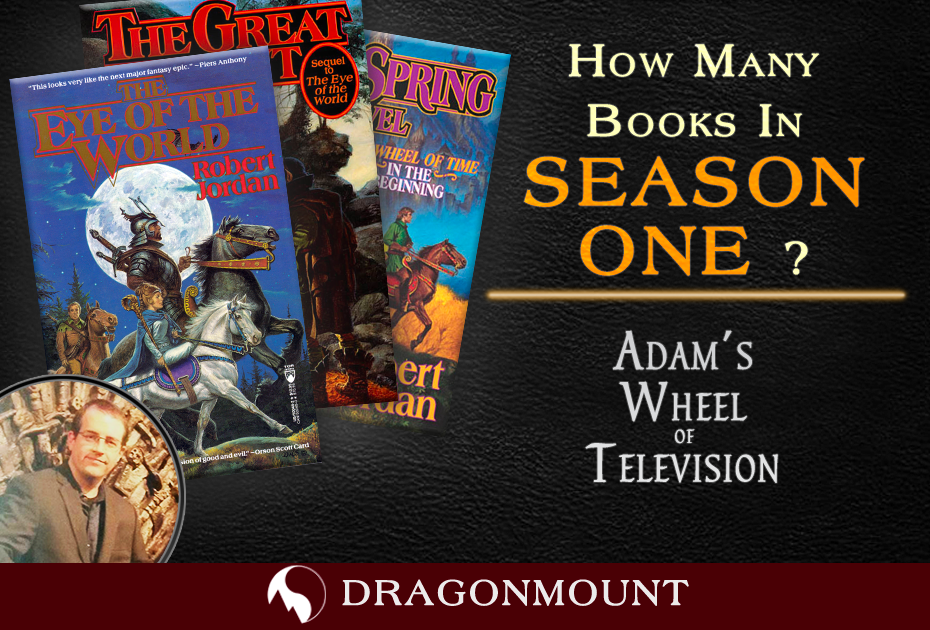
Adam Whitehead is Dragonmount's TV blogger. Adam has been writing about film and television, The Wheel of Time, and other genre fiction for over fifteen years, and was a finalist for the Hugo Award for Best Fan Writer in 2020. Be sure to check out his websites, The Wertzone and Atlas of Ice and Fire (including The Wheel of Time Atlas!) as well as his Patreon. As production resumes on Season 1 of The Wheel of Time, a familiar question has reared its head again: how much material from the books will the first season cover? This is a key question because The Wheel of Time is, by some measures, the longest work of epic fantasy ever published. The series itself spans fourteen large volumes, a prequel and two companion works. The series is almost 12,000 pages long in paperback, containing more than 4.4 million words (approximately ten times the length of The Lord of the Rings) and taking twenty-three years to publish. Adapting it to a television series which might be lucky to last seven or eight seasons is going to require very extensive changes, far moreso than even the changes required to adapt George R.R. Martin’s A Song of Ice and Fire into its TV equivalent, Game of Thrones; although I suspect Rafe Judkins and his team will at least be very happy that they have a complete story to work from. This question became more challenging once it became clear that Season 1 of The Wheel of Time will only consist of eight episodes, which will almost certainly be the standard one-hour length of most Amazon television series. For contrast, Game of Thrones had ten episodes to adapt the first novel in that series, a novel which is only marginally shorter than The Wheel of Time’s first volume, The Eye of the World. It could be argued that The Eye of the World has a somewhat more relaxed pace and certainly a much smaller cast than A Game of Thrones, with a more linear story which keeps the characters together in the same location for much of its length, so there is scope to depict it more quickly, but even so there are limits on what I think will be possible in terms of compression. We also know the names of the first six of the eight episodes in the season: Leavetaking, Shadow’s Waiting, A Place of Safety, The Dragon Reborn, Blood Calls Blood and The Flame of Tar Valon. On the basis of the titles alone (and the perceived overall need to fit in two books per season), some have suggested that the show will try to fit The Eye of the World and The Great Hunt into the first season. On this basis, Leavetaking will span most or all of the events of Winternight, our heroes meeting Moiraine, the Trolloc attack and the subsequent flight from the Two Rivers; Shadow’s Waiting will focus on the side-trip to the ruined city of Shadar Logoth; A Place of Safety could refer to Caemlyn and Egwene and Perrin’s adventures with the Tinkers; The Dragon Reborn would feature the events in Fal Dara and the Blight; Blood Calls Blood would feature the events in Fal Dara leading to the theft of the Horn of Valere and The Flame of Tar Valon would introduce the Amyrlin Seat. These all seem like fairly logical extrapolations. In addition, we know several characters have been cast who do not appear until Book 2, most notably Siuan, Leane, Alanna and her Warders, and Liandrin. However, there are several problems with this interpretation. The first is the casting has been announced roughly in keeping with the table reads for the series. Maria Doyle Kennedy and her fellow actors playing Tinkers were not unveiled until the Episode 5/6 table read, suggesting that the Tinkers will not appear until these episodes. The second is that much of the casting for the show was leaked before it was officially announced, and we have had no indications at all of casting for key Book 2 roles such as Ingtar, Hurin, Suroth, Egeanin, Verin or King Galldrian (although we should also note we have still not had several key Book 1 cast announced yet, most notably Elayne, Galad, Gawyn, Morgase, Elaida, Bayle Domon and Lord Agelmar). We also have a reasonable list of filming locations so far and none of the places involved would seem to reflect key Season 2 locations, such as Falme or Cairhien (indeed, the shooting locations for this week seem more reminiscent of the Blight, or Tarwin's Gap). In addition, Johann Myers who plays Padan Fain has only been booked to appear in one episode of Season 1, with the potential to return for future seasons. I would submit that doing the start of The Great Hunt, let alone all of it, without Padan Fain is untenable. Finally, we know that the Eye of the World material will be supplemented by a new storyline focusing on Logain, his capture and his taking to Tar Valon for trial and gentling, with actor Alvaro Morte booked for multiple episodes of the first season. A rushed Eye of the World, which is only covered in four hours, doesn’t seem like it leaves much room for a major new multi-episode arc focusing on a different set of characters. We also know we are getting flashback scenes to Siuan’s childhood (as an actress has been cast to play Siuan as a young girl) and potentially to the events of New Spring (an Aes Sedai who only appears in New Spring and dies during its events has been cast); fitting in a large amount of new material when they are trying to cram two long, epic books into just eight hours would be very difficult. Revisiting the episode titles with this knowledge, they can be given different explanations: The Dragon Reborn could focus on the battle against Logain and his capture, whilst in The Flame of Tar Valon he arrives in Tar Valon and is tried and gentled. During this storyline we would meet the Book 2 characters who show up early: Alanna, Siuan, Leane and Liandrin. This would also be a likely explanation for why Eamon Valda has been cast in Season 1. Although oft-mentioned in the first six books, he doesn’t actually appear in-person until Lord of Chaos. However, we do know that he was part of the detachment of the Children of the Light who helped defeat Logain (studiously avoiding all Aes Sedai contact in the process), followed them to Tar Valon via Caemlyn and generally made a nuisance of themselves outside the city. Blood Calls Blood is a trickier one, especially if it’s the same episode the Tinkers first appear in. It may be that the TV show has repurposed the saying from the Prophecies of the Shadow to be more related to the wolfbrother abilities. On the other hand, it might be that the dark prophecies will be quoted and appear earlier on than they do in the books, perhaps in one of the dream sequences that litter the first volume. The curious issue of pacing is still a valid one. We know from Brandon Sanderson’s set visit that Episode 2 opens with the events in Taren Ferry. Perhaps the action cuts quickly from fleeing Taren Ferry to Shadar Logoth (potentially bypassing Baerlon altogether, with Min’s late casting announcement suggesting she appears somewhere else, perhaps Basel Gill’s inn) based on the episode titles, but that then leaves a fairly yawning chasm between fleeing Shadar Logoth (presumably at the end of Episode 2) to Perrin and Egwene meeting the Tinkers (apparently in Episode 5). One solution I’ve seen theorised is that Episode 2 actually does feature more material related to the flight from the Two Rivers and Shadar Logoth is presented as “a place of safety” they can flee to; the Shadar Logoth events take place in Episode 3 instead and then Episode 4 cuts away mostly to Logain’s story, picking our heroes back up in Episode 5. A third solution also does raise itself. We’ve been focused very much on Season 1, but we also need to consider the bigger picture of the entire series. It’s extremely unlikely the series will go for much longer than seven or eight seasons in total due to the mounting cost of cast salary renegotiations (the expense of which eventually made even global mega-hits like Game of Thrones and Friends unsustainable at a certain point), so packing in the entire saga as it appears in the books is simply impossible, as that would take more like fourteen seasons. If eight-episode seasons are going to be the norm (as they are for many Amazon projects), Rafe Judkins and his team potentially have less episodes than Game of Thrones did to tell a story more than twice the length in the books. This requires a dramatically different kind of adaptation, one that simply cannot afford to be “faithful” to the text in the same way as Game of Thrones’ early seasons or Peter Jackson’s Lord of the Rings movies. Trying to do that would likely result in the series being left incomplete. Instead, the approach may be to take the entire book series as one whole and then dramatically cut, compress, combine and streamline events into a shorter, more focused narrative, whilst trying to remain true to Robert Jordan’s themes and the general big picture. Taken from this perspective, trying to map which books will appear in which season may be futile, with the showrunners instead conflating storylines, characters and locations in a more dramatic manner than fans are perhaps expecting. On this basis the first season may draw on elements, scenes and characters from several books whilst still trying to achieve the narrative objective of introducing the characters and world and setting up the storyline. With shooting due to resume in the next couple of weeks, hopefully we’ll get some shots and information from the Episode 7/8 table read which will confirm those episode titles, which should gives us some more information to work with. As usual, let us know your thoughts and keep an eye on the Dragonmount TV page for more Wheel of Time news.
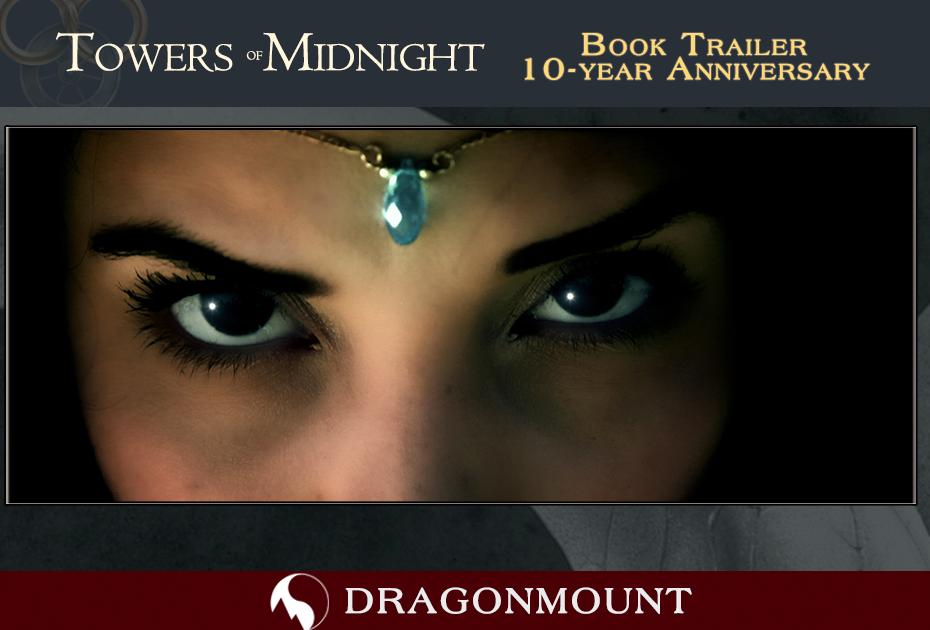
10 years ago today, on September 3, 2010, Dragonmount premiered the Towers of Midnight book trailer. This promotional video was funded by Tor Books and made with the blessing of Harriet McDougal and Brandon Sanderson. It features Sarah Nakamura in the small role of Moiraine. Today, Sarah is a Story Consultant for Amazon Prime's upcoming Wheel of Time TV show. Making that video was a lot of fun. Be sure to check out our extensive behind-the-scenes feature about its making.

In our latest episode of The Wheel of Time Community Show, Kitty teaches us how to bake Wheel of Time Honeycakes! You can download the full recipe here: WoT_Honeycakes.pdf Wheel of Time Honeycakes Notes * Remove any storage items from the oven before preheating. * If using regular table/iodized salt instead of kosher salt, use half the amount of salt. * In a hot kitchen, chill prepped ingredients and dough as needed. * If you don’t want excess honey butter, halve the recipe for it. * If working with a half batch at a time, wrap the other half of the dough with plastic wrap and refrigerate. * Put a bowl of flour by your work surface when rolling the dough. Pour it back into the container when done. * Have fun. It’s not a souffle. Ingredients - volume | weight Dough 3 cups | 13.5 ounces all purpose flour 1 tablespoon baking powder 1 teaspoon kosher salt 1 cup dairy milk (any percentage) 1/4 cup | 2 ounces honey 1 1/2 sticks | 6 ounces frozen unsalted butter (freeze in wrapper) Honey Butter 6 Tablespoons | 3 ounces unsalted butter roughly chopped into chunks 6 Tablespoons | 3 ounces honey 1 teaspoon kosher salt Directions Grate 6 ounces of frozen butter with a box grater (side with big holes). Put back in the freezer. Place an oven rack in the center and preheat the oven to 400 degrees. Line a baking sheet with parchment paper. Make the honey butter. Place the butter chunks, honey, and salt into a microwave-safe bowl. Microwave at 10-second intervals, stirring in between each one until the butter is almost melted. Keep stirring until fully combined and set aside. In a bowl, whisk the flour, baking powder, and salt for one minute. In a separate bowl, mix the milk and honey until completely combined. Add the grated butter into the flour and mix until it's the size of small peas, or until uniform. Slowly drizzle in the milk and honey mixture into the flour and mix gently just until there are no dry spots. Lightly flour your work surface and plop the dough out. Gently pat it into a rough rectangle and then roll to about 1/2 inch thick. *If you don’t want to fold the dough, roll it to 1 inch thick instead and skip to step 7*. Get the honey butter and lightly brush it onto the dough. Fold it in thirds, like a letter, rotate 90 degrees, and roll it into a 1/2 inch thick rectangle again, sprinkling flour as needed for stickiness. REPEAT THIS TWICE MORE for a total of 3 rounds of folding. After the last round, roll it to about 1 inch thick. Slice off all 4 edges of your dough rectangle as close to the side as possible. Lightly roll/pat these into weird looking dough balls. Cut the dough in half the long way, and then evenly cut 4 times across to make a total of 10 honeycakes. Place them on the parchment paper/baking sheet, keeping them at least an inch apart. Don’t forget to add the weird scrap dough ones! Brush the tops and sides with more honey butter and bake at 400 degrees until the tops are nicely browned, 12-16 minutes with rotating halfway through. Brush the hot honeycakes with more honey butter, and walk away. Let cool for at least 10 minutes. Serve with… more honey butter! Please leave comments and suggestions below. We love hearing from you!
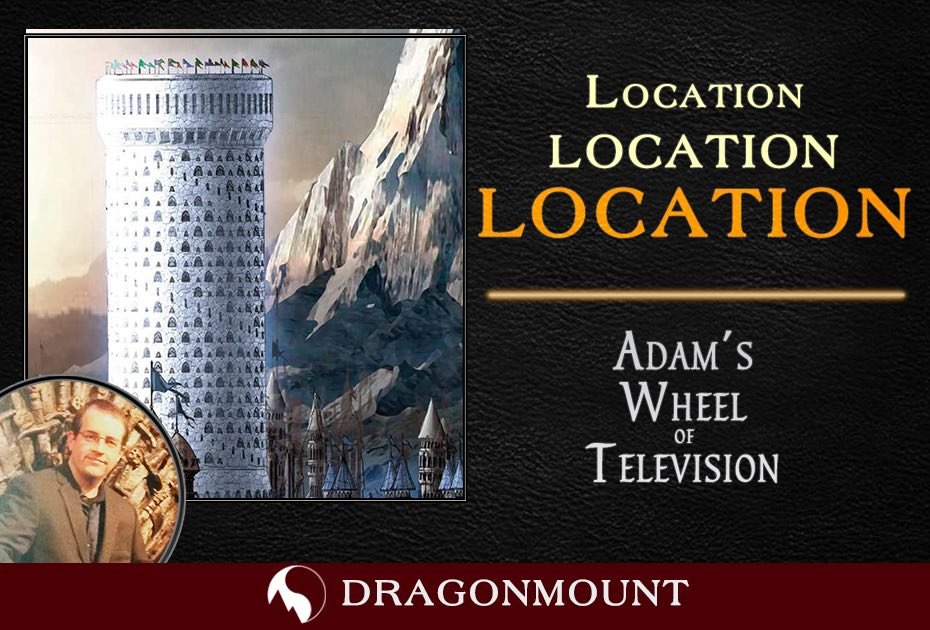
Adam Whitehead is Dragonmount's TV blogger. Adam has been writing about film and television, The Wheel of Time, and other genre fiction for over fifteen years, and was a finalist for the Hugo Award for Best Fan Writer in 2020. Be sure to check out his websites, The Wertzone and Atlas of Ice and Fire (including The Wheel of Time Atlas!) as well as his Patreon. Work on the Wheel of Time TV series is spooling up again after a long break due to the coronavirus pandemic. Most of the cast and crew is now back in the Czech Republic, more casting has been announced and shooting should be resuming fairly soon for the last leg of production so, hopefully, we can see the show early next year as originally planned. Whilst that work continues, it may be interesting to consider something we haven’t talked about much so far: locations and places in The Wheel of Time and how they will be depicted on screen. The Wheel of Time spans numerous cities, towns, villages, nations and areas of wilderness scattered across a landmass considerably larger than the United States, as well as (very) brief jaunts to other continents and islands. One of the weaknesses of depicting fantasy on screen for decades was how to depict such locations on a limited budget. Peter Jackson cracked that in his Lord of the Rings movie trilogy – aided by a competitive exchange rate – by scouring the entire nation of New Zealand for interesting locations and building towns and cities on naturally-occurring landforms, using a mixture of CGI, forced-perspective, models and actual physical sets, sometimes in a logistically challenging manner. The construction of Edoras, the capital of Rohan, was a major enterprise involving construction workers spending months building on Mount Sunday, a remote hill in a mountain valley several dozen miles from the nearest town, for just two weeks of filming. These scenes were then augmented in post-production with additional CG buildings. Similarly, HBO’s Game of Thrones presented us many cities on a limited budget. The great city of King’s Landing, capital of the Seven Kingdoms, was built on sets but also through location filming, principally in the city of Dubrovnik, Croatia, but also locations in Malta, Spain and on soundstages in Northern Ireland. Locations in Spain and Morocco, again backed up by a large amount of CGI, augmented these to build up other cities such as Qarth, Astapor, Meereen, Braavos, Volantis and Oldtown, creating distinctive environments out of a small number of filming locations. The Wheel of Time starts small in the bucolic backwater of the Two Rivers but soon grows larger. In the first book alone we visit the large towns of Baerlon, Four Kings and Whitebridge, the ruined and crumbling metropolis of Shadar Logoth and the cities of Caemlyn and Fal Dara, along with half a dozen villages along the Caemlyn Road. We also travel the banks of the mighty Arinelle, cross the enormous plain known as Caralain Grass and risk the High Pass through the foothills of the Mountains of Dhoom to find the home of the Green Man, Someshta. Later books take us to the great cities of Tar Valon, Cairhien, Illian, Tear, Ebou Dar, Tanchico and Far Madding (among others) and the ancient, unfinished city of Rhuidean. The TV producers may also be tempted to include flashbacks to the Age of Legends and vast, vanished cities like Paaran Disen (seat of the Hall of Servants) or V’saine (home of the great floating laboratory known as the Sharom, where the Bore was created), or travel to the Seanchan home continent to behold the imposing Court of the Nine Moons. The Wheel of Time has hundreds of strange and evocative places, many or most of which the TV producers will have to recreate for the show. We already know that The Wheel of Time has a generous budget and we will be seeing some of these places on screen. Emond’s Field, chief village of the Two Rivers, has been partially built as a physical set on location in the Czech Republic, and I wouldn’t be surprised to see some economic redressing and shooting from different angles to sell this village as several different villages. Taren Ferry is also present, and it seems a waste to have the main soundstages located in the great city of Prague and not make use of its historic buildings and period architecture to depict the streets of Caemlyn or Tar Valon (or both!). Computer graphics will no doubt give us impressive aerial establishing shots of these places as well. CG will also likely be employed to depict the various mysterious and strange other dimensions our characters encounter: the Ways, the Portal Stone worlds, the enigmatic world of Sindhol (home of the Ael’finn and Eel’finn) and Tel’aran’rhiod, the World of Dreams. Always know where the nearest post office is. Depicting the locations is one thing, but you also need to make sure the audience knows where they all are. Fantasy novels almost always come with a map in the front pages of the book, or in the case of hardcovers sometimes realised as a spectacular full-colour painting, located conveniently for readers to be able to refer to as they read. This is less convenient for a TV show or film. The Lord of the Rings got around this by having maps appear in the film itself, with characters like Bilbo or Faramir pouring over them to decide their next move. Game of Thrones had, of course, a title sequence built around a map, with the locations appearing in that episode appearing on the map, with the camera swooping through them as they raised out of the ground. I suspect Wheel of Time will not copy that device, but getting the geography of the story across to the audience in a manner that doesn’t take them out of the moment is an interesting challenge. What locations are you looking to appearing in the show? As usual, let us known in the comments and keep an eye on the Dragonmount TV page for further news.
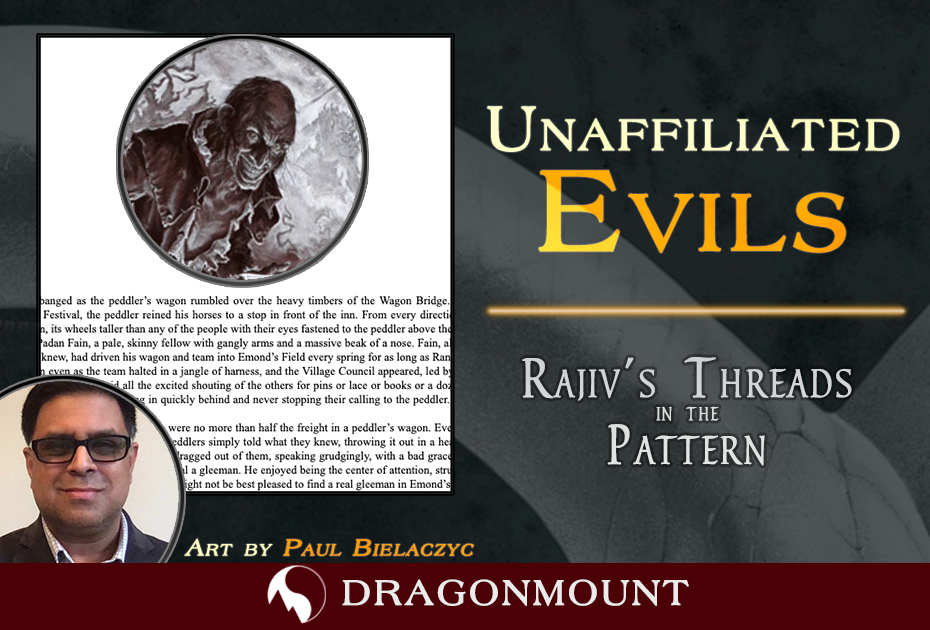
Rajiv Moté is Dragonmount's book blogger with a lens on the craft of fiction writing. When he's not managing software engineers, he writes fiction of his own, which can be found cataloged at his website. The Dark One is the source of evil in The Wheel of Time, and his army of monsters is formidable. Hulking man/beast soldiers, eyeless swordsmen, soul-sucking bat-men, unnoticeable assassins, evil hounds, Power-resistant gumbies, giant worms, and the giant insects they become. But the scariest monsters in the saga are creatures without a direct link to the Dark One, unaffiliated evils who haunt the corners of the Pattern, with nefarious purposes beyond the battle between the Dark One and the Dragon. Let’s look at five of them. Shadar Logoth “Suspicion and hate had given birth to something that fed on that which created it, something locked in the bedrock on which the city stood. Mashadar waits still, hungering.” “Shadows Waiting”, The Eye of the World Shadar Logoth is the name of a haunted city, but also of a triumvirate monster composed of ghosts, a mist creature called Mashadar, and a corrupting taint. Its evil has a complex and murky history, but its origin is human. It was initially kindled by people’s paranoia and ruthlessness against the Dark One. In some ways, it is like an echo of the Dark One himself, trapped in the prison of Shadar Logoth at the moment of its creation, needing human action to escape and touch the world with its corruption. But its evil “vibrates” at an opposite frequency to the Dark One’s, a pivotal piece of natural philosophy that caused Rand al’Thor’s wounds from the ruby-capped dagger and Ba’alzamon’s staff to war against each other instead of destroying him, and inspired Rand to cleanse the Dark One’s taint on saidin. Though there are invisible watchers and the ghostly counselor Mordeth himself haunting Shadar Logoth, the evil manifests as Mashadar, a mindless, chthonic monster emerging from deep in the earth only at night, blindly seeking prey with its misty tentacles. Shadar Logoth is one of the scariest parts of The Wheel of Time, the place where Robert Jordan unleashed the horror-writing chops he hinted at in the dream-scenes with Ba’alzamon. But the monster’s human origins make it fascinating, and Robert Jordan’s cosmology more complex. Whatever the glossary says, the Dark One is not the source of evil in The Wheel of Time, or at least not the sole source. Evil comes from people’s hearts, and when it is sufficiently strong, it can manifest monstrously. Perhaps the Dark One himself was created by humans in the infinite turnings of the Wheel. Machin Shin “Something left from the Time of Madness, perhaps,” Moiraine replied. “Or even from the War of the Shadow, the War of Power. Something hiding in the Ways so long it can no longer get out. No one, not even among the Ogier, knows how far the Ways run, or how deep. It could even be something of the Ways themselves. As Loial said, the Ways are living things, and all living things have parasites. Perhaps even a creature of the corruption itself, something born of the decay. Something that hates life and light.” “What Follows in Shadow”, The Eye of the World The Black Wind could be a creature of the Dark One in the way the creatures of the Blight are: a product of the Dark One’s taint. But it seems to be a chthonic monster more similar to the evil of Shadar Logoth than the Dark One, a collection of voices confined to its domain, and happily gobbling up Shadowspawn as readily as any other intruder. Moiraine makes the likeness between Shadar Logoth’s evil and Machin Shin explicit when she describes the Mordeth-possessed Padan Fain’s encounter with it. “The Black Wind caught him--and he claimed to understand the voices. Some greeted him as like to them; others feared him. No sooner did the Wind envelop Fain than it fled.” “More Tales of the Wheel”, The Eye of the World Machin Shin and the Ways are another wonderfully creepy horror flex by Robert Jordan, and it’s a shame that the in-canon conclusion of the series wasn’t able to resolve its threat. Out of canon, at least we have “A Fire Within the Ways,” a deleted chapter from A Memory of Light (jointly credited to Robert Jordan and Brandon Sanderson) appearing in the Unfettered III anthology. In it, Perrin leads a mission to disrupt the Dark One’s armies from using the Ways, and at the climax of the battle, Machin Shin attacks. Neither weapons nor the One Power harm it, but then they hear a pure rumble of Ogier voices raised in song. Something in the song allows the Asha’man and Aes Sedai to channel bright, uncorrupted light, and Machin Shin is driven back into the shadows. If the evil of Shadar Logoth seemed like a primitive prototype of the Dark One in miniature, bound in its prison and reaching the world through human proxies, Machin Shin mirrors him in other ways. It is a formless but sentient evil that exists outside of the Pattern, known only because the Aes Sedai reached into the liminal space where it lurks. Hinderstap’s Ghosts “The road’s length squirmed with shadows, figures battling, screeching, struggling in the deepening gloom. In that darkness, the fights looked at times to be solid, single creatures--horrific monstrosities with a dozen waving limbs and a hundred mouths to scream from the blackness.” “Night in Hinderstap”, The Gathering Storm By day, the people of Hinderstap are welcoming, but they insist that visitors leave before nightfall. Because night is when the entire town goes murderously insane, and everyone fights each other to the death. By morning, they all wake up in their beds, fully healed, with no memory of the night’s carnage. Any outsider unlucky enough to be killed in the madness joins the cycle of violence, forever. Hinderstap is an eldritch stopover that doesn’t seem to be connected to anything else in the saga, though it has a fun payoff during the Last Battle. The chapter icon suggests that what’s happening in Hinderstap is a result of the Pattern unraveling. But we’ve seen these localized, nocturnal curses before, and the above description tickles a memory. “The waving gray tentacles of Mashadar blocked half the street, and the Trollocs were balking… The thickening tentacles of fog swung uncertainly for a moment, then struck like vipers… There was no sound from that cry, any more than from the Trollocs, but something came through, a piercing whine just beyond hearing, like all the hornets in the world, digging into Rand’s ears with all the fear that could exist.” “Dust on the Wind”, The Eye of the World Perhaps there was another deleted chapter in which Mordeth, in Padan Fain’s body, spent some time in Hinderstap, leaving his corrupting influence to seep into the bedrock. Certainly one can imagine that the nightly carnage in Hinderstap had some analogue in Aridhol at first, and over the centuries its undying people became little more than mist and shadowy watchers. The Aelfinn and the Eelfinn “The game is a remembrance of old dealings. It does not matter so long as you stay away from the Aelfinn and the Eelfinn. They are not evil the way the Shadow is evil, yet they are so different from humankind they might as well be. They are not to be trusted, archer. Stay clear of the Tower of Ghenjei.” “To the Tower of Ghenjei”, The Shadow Rising The Aelfinn (the “snake people”) and the Eelfinn (the “fox people”) are ancient folk who live in a different, geometry-bending world called Sindhol, accessible only through ter’angreal portals and the mysterious Tower of Ghenjei. They share similarities with genies and fae, granting wishes (if not always in the ways hoped for) and imparting truths (while exacting a price). They also feed on memories and sensations, and can watch the world through the eyes of those they’ve touched. If Shadar Logoth and the Ways gives readers a dip into chthonic horror, Sindhol is a foray into dark fairy tales. The Aelfinn and the Eelfinn even seem to share an origin with a creature in a Neil Gaiman story. “‘And what do you take, for the gold you give them?’ Little enough, for my needs are few, and I am old; too old to follow my sisters into the West. I taste their pleasure and their joy. I feed, a little, feed on what they do not need and do not value. A taste of heart, a lick and a nibble of their fine consciences, a sliver of soul. And in return a fragment of me leaves this cave with them and gazes out at the world through their eyes, sees what they see until their lives are done and I take back what is mine.” “The Truth Is a Cave In the Black Mountains”, Neil Gaiman The ’finns are the perfect foil for Mat. While Rand contends with the political machinations of the lands he tries to unite, Mat plays a game against inhuman creatures with unfathomable desires. He has to discover the rules as he plays, the stakes are staggeringly high, and the only way to win is to cheat. Who better to take them on, than the Wheel’s trickster figure? Instead of being armed with prophecy and ta’veren destiny, Mat’s rescue mission is armed with folklore, lessons from a children’s game, and pure luck. Fortunately, Mat is the luckiest man alive. The Children of the Light “There are a lot of men coming, on horses. They came up behind the wolves, but the men didn’t see them… But Dapple says… Dapple says they smell wrong. It’s… sort of the way a rabid dog smells wrong.” “Children of Shadow”, The Eye of the World Shortly after the War of Power that sealed the Dark One and (most of) the Forsaken in their prison at Shayol Ghul, there were angry men who decided to take “justice” into their own hands. They rooted out and punished people they believed served the Forsaken. Their spiritual successors became the Children of the Light, dedicated to finding and destroying Darkfriends wherever they may be. The Whitecloaks are so fanatical (even before encountering Mordeth’s corruption) that, to wolves, they smell rabid. They see improper respect paid to them, or casual association with Tar Valon, the Power, or anything unexplained, to be proof of being a Darkfriend. Their Questioners seem modeled on the Spanish Inquisition. They’re bigots and bullies, so convinced of their own righteousness that they’re willing to cross any line to accomplish their goals. If the evil of Shadar Logoth was human in origin, the Children of Light show that the same evil remains alive and well in humanity itself. It’s the most mundane evil in The Wheel of Time, but the most pervasive, persistent, and real. They embody what William Butler Yeats described in his apocalyptic poem “The Second Coming” with “The best lack all conviction, while the worst are full of passionate intensity.” The Fourth Age has cleared the field of many dangerous foes, but the danger of people like the Whitecloaks is always with us. Rand al’Thor remade the world to preserve human free will, which is why the struggle against the Shadow will continue forever, even if the Dark One is locked back in his prison. What’s your choice of scariest monster from The Wheel of Time?
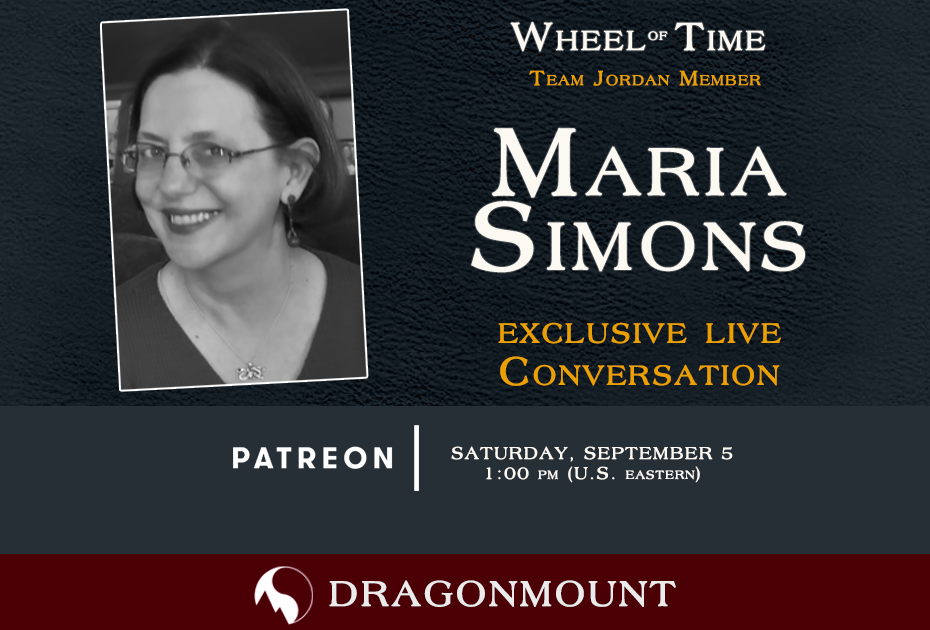
We're proud to announce the first in our series of exclusive Patreon guest chats, featuring Maria Simons on Saturday, September 5, 2020 at 1 PM U.S. Eastern Time. This event is available to our Patreon supporters. Learn more and sign up here. About Maria Maria is a member of Team Jordan as well as the long-time research assistant to Robert Jordan and Harriet McDougal. She's perhaps the world's foremost expert on Wheel of Time lore, as well as the co-author of The Wheel of Time Companion. You will not find a more enjoyable, humorous, and knowledgable person related to this franchise. About the Event This will be a LIVE virtual event, held over Zoom. All Patreon supporters at the Heron-Marked ($10) level and higher are invited. If you are a not yet a Patreon supporter, or if you are a supporter at a lower tier, you are welcome to "upgrade" to the Heron-Marked level for a single month to gain access to this event. More information about signing up is available on our Patreon page. The event will begin with a moderated discussion with our guest, followed by an open Q&A where you can freely ask questions and chat. This is expected to be a somewhat smaller event, but if the number of attendees grows, we will moderate it but give everyone a chance to ask questions and be involved. The Zoom link will be emailed to all eligible patrons 24 hours before the event. I hope you'll join us for this exciting event! If you can't make it this time, that's OK, we'll record it and also host future chats with other special guests tied to The Wheel of Time franchise.
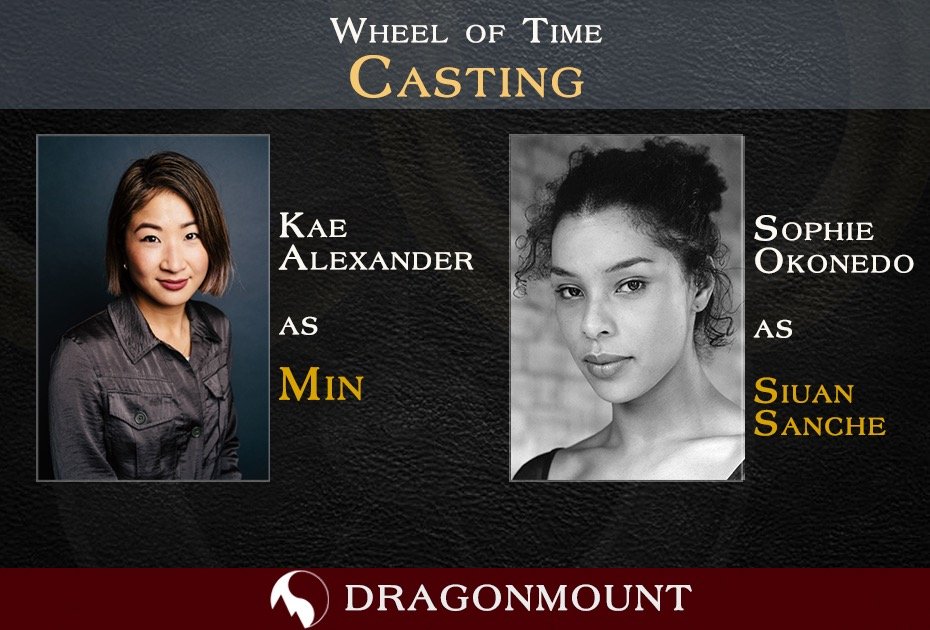
Amazon Prime's Wheel of Time television show had some major announcements for #WoTWednesday today! Kae Alexander as Min Farshaw Sophie Okonedo as Siuan Sanche Kae Alexander is a BAFTA elevate actress. Kae recently filmed action feature INFINITE for Paramount Pictures and the MALEFICENT sequel for Walt Disney Pictures. Other recent credits include Fox thriller DEEP STATE, THE GREAT WAVE directed by Indhu Rubasingham for the National Theatre, ITV/Amazon thriller STRANGERS for Two Brothers Pictures, 4 part series COLLATERAL written by David Hare and directed by SJ Clarkson for BBC / Netflix, BBC crime thriller HARD SUN, Reb in Steven Spielberg's READY PLAYER ONE and Elaine in Phoebe Waller-Bridge's comedy FLEABAG. Sophie Okonedo's credentials are too long to list here, so we'll name a few. Sophie began her film career in 1991 in the British coming-of-age drama YOUNG SOUL REBEL before appearing as Wachati Princess in ACE VENTURA: WHEN NATURE CALLS (1995) and Stephen Frears' DIRTY PRETTY THINGS (2002). She received an Academy Award nomination for Best Supporting Actress for her role as Tatiana Rusesabagina in the 2004 film HOTEL RWANDA. Sophie also received a Golden Globe nomination for the miniseries TSUNAMI: THE AFTERMATH (2006) and BAFTA TV Award nominations for the drama series CRIMINAL JUSTICE (2009). We are so excited to have these actresses join the Wheel of Time family! Today, three other cast members were officially announced. We already knew they were involved, but it's nice to have it official. Kate Fleetwood as Liandrin Guirale Peter Franzen as Stepin Clare Perkins as Kerene Nagashi Kate Fleetwood is a Tony and Olivier nominated actress with a storied career on stage. Her extensive screen credits include leading roles in Harlots (Hulu/ BBC), Brave New World (Peacock), Fate: The Winx Saga (Netflix), Victoria (ITV / PBC Masterpiece) and Macbeth (PBS). Kate’s film work includes Les Miserables, Beiruit, Harry Potter and the Deathly Hallows: Part 1 and Star Wars: Episode VII: The Force Awakens. Peter Franzén is one of Finland’s most accomplished actors and has enjoyed a successful career both nationally and internationally. Franzén’s career has spanned 20 years and includes over 90 movies and series in several countries- in English, Finnish, Swedish, Russian, Estonian speaking productions. He has been awarded three Jussi Awards (Finland’s Academy awards) and a total of seven nominations. He has also received awards from international film festivals. London born and raised and graduate of Rose Bruford College, CLARE PERKINS' is a British actress with almost 30 years in the business. Having performed at some of the most prestigious London theatres such as the Almeida Theatre, Donmar Warehouse, Hampstead Theatre, Royal Court Theatre and the Gielgud Theatre, Clare has more recently been making a name for herself on screen, soon to be seen in Netflix crime drama, YOUNG WALLANDER. She will also star in series 4 of popular Netflix series, THE CROWN and the second series of comedy drama FLACK with Anna Paquin. Things are starting to come together. Perhaps a ta'veren is involved. We don't see Siuan in the series until the start of The Great Hunt. Is the fact Sophie Okonedo's been cast now a sign Siuan will pop up earlier than expected? Let us know what you think in the comments below. And be sure to check out our team's reaction The Wheel of Time Community Show:
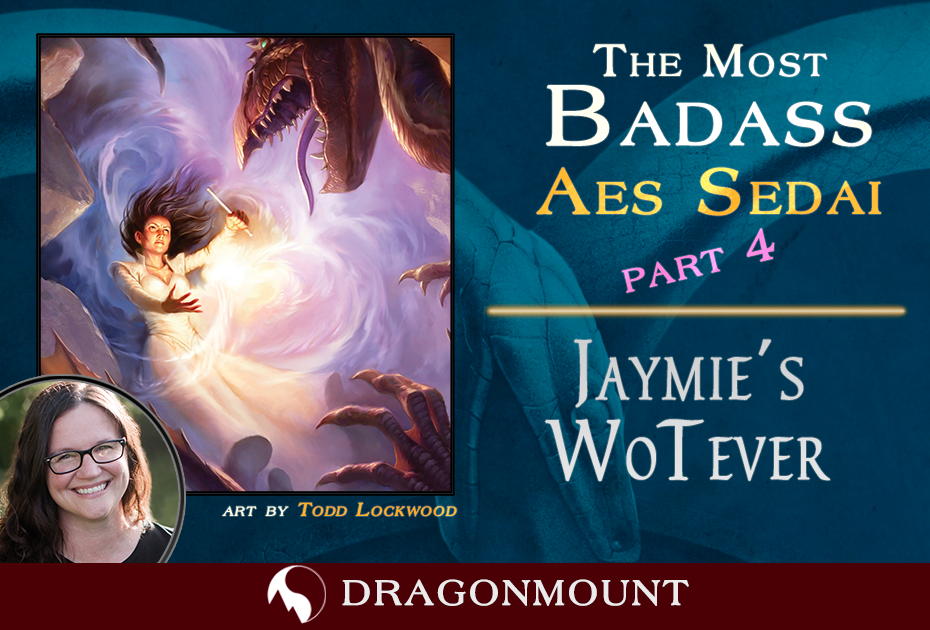
Jaymie here. I’ll be discussing a wide variety of topics related to The Wheel of Time. Like many of you, I’ve been reading WoT since the Age of Legends, so we’ll have lots to cover together…WoTever comes to mind. WARNING: THIS POST CONTAINS MAJOR SPOILERS Affecting change out in Randland or as Sitters in the Hall, who’s the biggest badass of them all? In this series, I took a look at our own G.L.O.W. – the Glorious Ladies of WoT, specifically the smooth-cheeked, serenity-filled, skirt-smoothing, shawl-adjusting, butt-kicking Aes Sedai. I selected the most badass sister from each Ajah, as well as a runner-up for the title. In Part One, we chose out the most badass Aes Sedai of the Green, Red, and Gray Ajahs. The Blue, Yellow, White, and Brown Ajahs saw their badass representatives hailed in Part Two. Part Three examined the dark side of badassery as the Black Ajah had their day. In Part Four, it’s time to revere the ULTIMATE Badass Aes Sedai in all of Randland. Of All Ajahs and Of None Egwene al’Vere Part One in our series took a look at the Badasses of three Ajahs, Green included. I received a LOT of feedback in the “BUT WHAT ABOUT EGWENE?!” category. I heard you. I did! But I had to save her for Part Four. She may have identified as Green, holding her would-be Ajah in her heart, but her extraordinary circumstances created an Amyrlin like no other: they may all claim it, but only Egwene was truly and literally of all Ajahs and of none. And she became the absolute embodiment of Aes Sedai as she served, protected, battled, guided, maneuvered, and sacrificed her way to legend status. So, let’s talk about Egwene – most of the good, some of the bad, and all of the awesome. Maybe she’s born with it… Canonically, none of the major female characters are ta’veren. However, we must allow that the Pattern provided Egwene a lot with which to work: She’s one of the strongest channelers in a thousand years. She picks up channeling remarkably quickly and astounds other Aes Sedai by being able to split her flow of the One Power in 14 ways. She’s a Dreamer. Obviously, this comes in super handy throughout the series. (And as often as she’s mentioned, who else thought we might somehow get to meet Corianin Nedeal? Perhaps weirdly trapped in T’A’R? Maybe just me?) Genetics and family history also come through for the assist – mayor dad, Women’s Circle member mom (in a small village, true, but she’ll still pick up on politics and group dynamics), Wisdom’s apprentice (again, yes, for a small village, but the Wisdom is Nynaeve, yo), and she carries the blood of Manetheren in her veins (*acknowledges the ongoing Egwene/Queen Eldrene reincarnation discussion/debate*). Like her ancestors, she’s hard-working, resourceful, and tenacious. At its worst, that tenacity manifests as stubbornness (muley stubborn, the girl Amyrlin is!). But far more often, it shines as perseverance, dedication, and resolve. Oh, and she happens to have grown up with the Dragon Reborn. That might help down the road. Additionally, she’s wicked smart. Boldly going where no Randlander had gone before Along with her inherent traits and early-life experience, Egwene brings incredibly unique adventures to her interactions. She’s traveled the Ways. She's sat at the fires of the Traveling People. She witnessed the “exorcism” of Shadar Logoth evil from Mat. She’s been a Seanchan damane, where she learned their culture in the context of their greatest weapon, channeling; and was forced to rapidly develop her strength and dexterity in the Power (also coming in quite handily). And, of course, she lived among the Aiel as an apprentice to Wise Ones. She went to learn Dreamwalking, but she also, thankfully and serendipitously, learns and eventually lives the Aiel code of honor and obligation, ji’e’toh, taking it back with her to the wetlands. Egwene’s training from, edification through, and intimacy with the Aiel is a turning point in her fascinating trajectory. People…people who need people... Like all of our badasses, Egwene is not perfect. So much stuff has been crammed into this girl for the purpose of prophecy-fulfillment that her youth seeps out every now and then, usually in the form of immature self-preservation, and usually directed toward the people she grew up with. Examples: her early-series bratty treatment of Nynaeve (to which Elayne, of all people, puts a stop); her bullying of Nynaeve and Elayne so she wouldn’t be discovered sneaking around T’A’R; and her behavior toward Mat after he rescues the girls from the Stone of Tear. Rand remains a blind spot for her through nearly the entire series, as she often regresses back to a village-Wisdom’s-apprentice-type role when dealing with him. Even as the Last Battle begins, while they stand on the Field of Merrilor and Zen Rand reveals his plan to destroy the seals of the Dark One’s prison, Egwene hears only Stubborn Woolhead Rand, and treats her childhood sweetheart—and his plan—as such. And her relationship with Gawyn is, for some readers, nothing short of infuriating. That analysis would likely fill an essay of its own. However. I’m gonna give our young Amyrlin a few passes in light of endorsements from some tried and true badasses. Egwene has earned the respect of the Wise Ones, namely Sorilea, Bair, Melaine, and the incomparable Amys. When she announces she must leave, they are more than disappointed and want her to stay with them. Stay! In the Waste! A wetlander! Blue Ajah Badass and Amyrlin-turned-advisor Siuan Sanche also believes in Egwene, recognizing that she will “be an Amyrlin to make thrones tremble,” especially after Egwene reveals her plans for the Tower. (Lord Of Chaos, Ch. 37, When Battle Begins) When Egwene meets our beloved Gareth One-Of-The-Five-Great-Generals Bryne, he gives her his trust and his army. Do we, as readers, believe we can peg Eggy better than one Master Gareth Bryne? Do we?! And while she gains the respect of novices, Accepted, and finally Aes Sedai after her captivity in the Tower, her championing by Red Badass Silviana Brehon really seals the deal, for us readers and for the Tower. She did it all for the Tower (c’mon!) the Tower… Ironically, Egwene’s youth—or, lack of years—ultimately allowed for her greater vision, her grasp of the big picture. She seemed to have unbelievable political savvy for her age, but Egwene was so focused on the right things that she could see through the wrong. Lelaine and Romanda? She’ll use their faults to her advantage, playing them against each other to achieve her larger goal of uniting the Tower. Siuan makes lots of sense and respects her? She’ll soak up the former Amyrlin’s tutelage like sponge, for it will do nothing but help her unite the Tower. You rebels raised me Amyrlin and remained loyal to me? Awesome, but I don’t actually owe you anything. In fact, YOU owe the TOWER an apology, for your part in the break. Hop to, so we can get back to work uniting the Tower. Essentially, Egwene wasn’t bogged down by years and years of scheming and favors and grudges and personal goals. Her mind isn’t clouded with individual alliances, or “well, that’s not possible,” or “um, we don’t do that here.” When the Tower broke themselves, Egwene was able to respond with, “All bets are off. You ruined this. Now I’m going to fix it and you DO NOT get to tell me how.” Homegirl’s a badass, pure and simple. I’ll wrap this fourth Most Badass Aes Sedai installment with Egwene’s (arguably) Top Three Most Badass Moments: Honorable Mention (because, so many moments) Her overall maneuvering, first within the rebel camp, and then gloriously and so victoriously within the Tower. She shines when she gets the rebels off of their collective arse and cleverly declares war on Elaida in a beautifully written scene. Then she absolutely radiates as a prisoner in the Tower, as the culmination of every single positive trait Egwene possesses convinces the Tower Aes Sedai of their true goal. 3. The Seanchan attack on the Tower. “The woman stood like vengeance itself, the power of saidar like a storm around her. The very air seemed alight, and her brown hair blew from the wind of the open gap in the wall beside them. Egwene al’Vere.” - POV of Adelorna Bastine (The Gathering Storm, Ch. 40, The Tower Shakes) 2. The dinner that changes everything. When Egwene names Elaida coward and Elaida loses her actual damn mind, I’m ready to stand up and cheer. And then… “They could all see the weaves, and they could all see that Egwene did not scream, although her mouth was not gagged by Air. Her arms dripped blood, her body was beaten before them, and yet she found no reason to scream. Instead, she quietly blessed the Aiel Wise Ones for their wisdom” … “‘By the Light,’ Rubinde whispered.” (The Gathering Storm, Ch. 16, In the White Tower) Yes, girl. By the Light, INDEED. 1. The Flame of Tar Valon. Egwene discovers and channels the counter-weave to balefire, then wields it during the Last Battle to defeat the Sharans, knowingly sacrificing herself to make the stand. We all have a picture in our heads of Egwene’s blaze of glory, and no summary provided here will do that image justice. Do you agree with this Part Four assessment? Is Egwene al’Vere the ultimate Badass Aes Sedai? What other moments are her most badass?
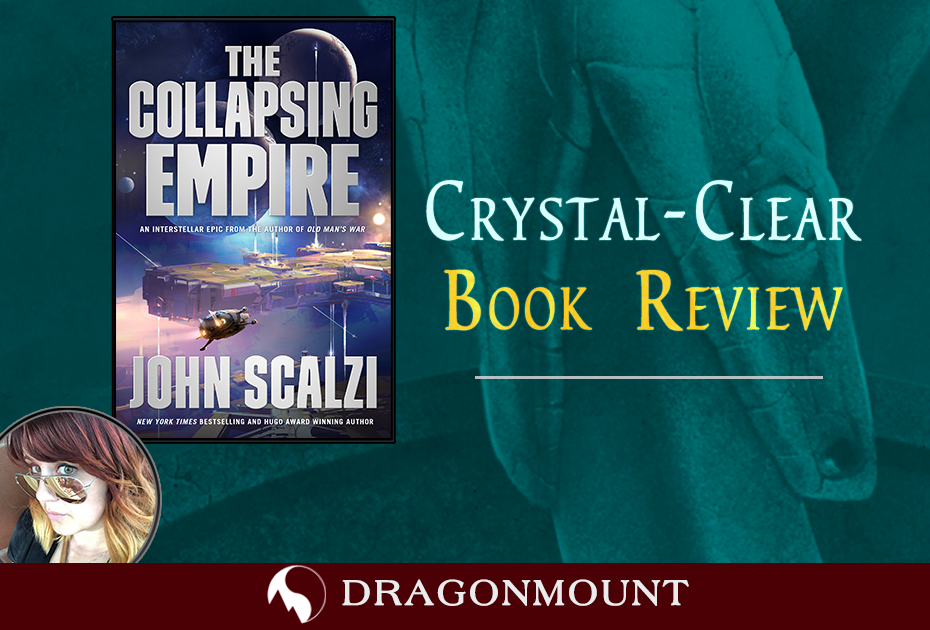
The Collapsing Empire by John Scalzi I have reached an important conclusion concerning my identity as a reader. I am officially a science fiction fan. I can go on to add a willing and excited reader of science fiction. I am new enough to the genre to know I still have a lot to explore, but my first few forays in the world of science fiction have been a triumph. The Collapsing Empire by John Scalzi is no exception. In fact, since finishing this book I have already gone on to begin book two. In my mind that is the highest compliment I can give to an author; to immediately read more of their works. I learned that for me to truly invest myself into the world a fantasy or science fiction author creates, there has to be a certain level of familiarity. A blend of what truly exists in our world and the unique features of the universe that they have created. It is a delicate balance to borrow and adapt without seeming to “steal” too much of our reality. It is a dance I face daily in my own writing, and one that I think Scalzi executes masterfully. Being a relative newb to this genre, I often find myself rereading passages to make sure I understand what is being conveyed. When reading The Collapsing Empire, the rules of the world were presented in such a fashion it was almost as if I had always known of their existence. I hesitate to give away too much of this gem, but the book is set up as the possible future of the human race after Earth has been lost, or at least deemed uninhabitable. The majority of the population is spread throughout the universe and living on planets that are not truly inhabitable. The only civilization that lives on a planet’s surface, is the End. In order to survive they make use of The Flow, to sustain trade and keep each planet supplied with that they need to survive. The Flow, which is essentially a one-directional worm hole between planets is essential to the survival of the entire Interdependency. The question becomes, what happens when this pivotal network no longer functions as it should? Since its founding, the Interdependency has been led by the Emperox from the Wu family, and as the story begins the leader of the Universe is dying and his unwilling daughter is preparing to assume the weight of the entire system on her shoulders. As is true of any ruler, there are those who wish to control, or even replace her right from the first moments of her rule. While most of the story is told from only three characters' point of view, we are shown the deep impact of their decisions on the fate of the human race. This succinct and captivating novel can easily be finished in one midafternoon reading marathon, and Scalzi’s characters are so engaging that you truly won’t want to put it down. As I read the last sentence, I found myself feeling very grateful that I was able to immediately begin the next book in the series. I think having to wait for the next book would have been a reader’s torture. Do yourself a favor and pick up this book to have on hand for when you have a few hours to yourself. I can confidently say that you will enjoy this highly accessible Space-opera. The Collapsing Empire by John Scalzi is available from Dragonmount's store as a DRM-free ebook. You can also purchase it on Barnes & Noble, Amazon, and your local independent bookseller.
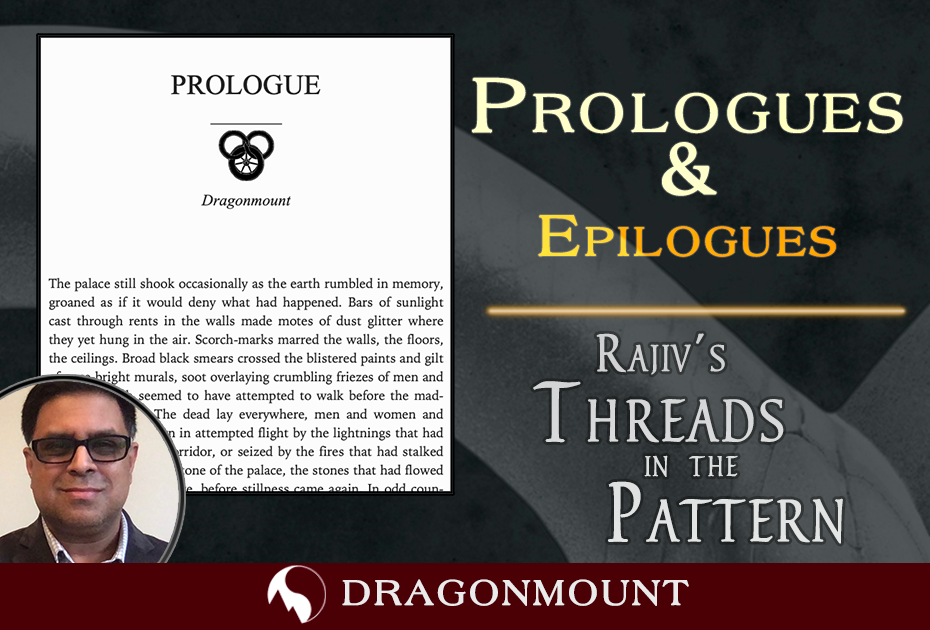
Rajiv Moté is Dragonmount's book blogger with a lens on the craft of fiction writing. When he's not managing software engineers, he writes fiction of his own, which can be found cataloged at his website. Spoilers below for The Wheel of Time books, and the prologues or epilogues of The Handmaid's Tale, A Game of Thrones, The Deathly Hallows, and The Return of the King. The Eye of the World begins with one of the most memorable prologues in epic fantasy, a confrontation between a fallen hero-turned-madman and a villain who takes no joy in his apparent victory. It drops tantalizing hints of a world that is never fully explained, along with the idea that this battle has raged through an endless cycle of ages. And in Chapter One, on an empty road, thousands of years later, the actual story begins. I love prologues and epilogues. They let authors--and their readers--play at the edges of the story. They bridge the installments, expand the world, or just provide more emotional build-up and release. The early-release Wheel of Time prologues, beginning with “Snow” from Winter’s Heart, were like trailers for long-awaited movies. The epilogues of comic books--and the post-credits scenes of the movies they inspire--suggest possibilities sometimes more exciting than the stories themselves. “The Grey Havens” in The Lord of the Rings taught grade-school-age me the notion of beautiful melancholy. In The Wheel of Time, the only books without a prologue are New Spring and The Shadow Rising. In the former’s first chapter, “The Hook,” Lan witnessing the end of the Aiel War feels isolated enough from the main story to feel like a prologue. In the latter book, parts of the first chapter were, in fact, a prologue in the advanced reading copy before being integrated. The Shadow Rising’s first chapter surveys a number of points-of-view, a technique both Robert Jordan and Brandon Sanderson used in subsequent prologues. “Snow” and the prologues that followed, seemed to be written specifically for advance release, checking in on several characters--major and minor--to tease the upcoming book. By contrast, Lord of Chaos is the first book where Robert Jordan used an epilogue, a practice he did not pick up again until 2003-2004, with Crossroads of Twilight and New Spring. But even as early as The Eye of the World, when Moiraine told Lord Agelmar what must be done with the Horn of Valere, and spied on Rand while declaring “the Dragon is Reborn,” Jordan used the final scenes less to conclude the arc of the current novel than to set up the next one. The final chapter, “After,” of The Great Hunt, was even more explicitly an epilogue, switching to an omniscient point-of-view to describe how the ending of the Hunt reverberated across the continent. Prologues and epilogues, whether labeled so or not, are consistent features of The Wheel of Time. They give readers a look at the story’s place in the larger world, either through new point-of-view characters (in a story with dozens already), or sweeping narration across ages and geography. Most Western notions of story demand that a story begins when the protagonists face a threat to their status quo, and ends with a new status quo. In big, secondary world stories, prologues and epilogues allow readers to break outside the structure of Aristotle's unities (action, place, time) and Gustav Freytag’s dramatic acts (exposition, rising action, climax, falling action, denouement). We glimpse people and events that inform--but are not part of--the story to come, or linger in the denouement, seeing how the story ripples beyond its bounds. For a bit longer, readers get to enjoy the world in which they are investing hours of imaginative immersion. The Eye of the World’s prologue puts Rand al’Thor’s story into the vaster context of an eternal battle between the Dragon and the Dark One, where Rand’s struggle becomes Lews Therin’s second chance. This widening scope shares similarities with the epilogue of Margaret Atwood’s The Handmaid’s Tale. It occurs hundreds of years after the events of Offred’s story. An academic puts Offred’s harrowing and uncertain fate into the context of the rise and fall of the oppressive regime of Gilead. In both novels, these story fragments, separated in time, reframe the main tale. Both offer hope in the long arc of history. They imply other stories. The “Dragonmount” prologue introduces readers to the saga’s real stakes. On the way to Tarmon Gaidon, though, there are hundreds of pages focused on the Aiel, the return of Hawkwing’s armies, the Shaido, the Bowl of Winds, Andor’s royal succession, and the schism and healing of the White Tower. The prologue keeps readers’ eyes on the prize. The prologue in George R. R. Martin’s A Game of Thrones does the same, letting the readers know that the Iron Throne is a distraction from the real threat: the Others are coming (someday?) with The Winds of Winter. The scope of epics means not every plot thread gets wrapped up when the core story ends. Falling action and denouement can be a narrow frame for the catharsis readers want. In “To See the Answer,” the epilogue to A Memory of Light, we know that the Light triumphed in Tarmon Gaidon, but we still want hints of what the future holds for our surviving heroes in the Fourth Age. The answers give us just enough to imagine the future. And like Sister Night stepping out onto a swimming pool at the end of HBO’s Watchmen, a mysteriously lit pipe suggests an entirely new set of possibilities that will only live in our imaginations. The Wheel turns. Sometimes we want more than just assurances that the story goes on. It’s not essential to know that, at the end of The Lord of the Rings, the mallorn tree that Samwise Gamgee planted became famous, and the beer of 1420 was remembered for generations. But it feels good. And fans young and old were glad to know that after Voldemort’s destruction, Harry married Ginny, Hermione married Ron, they all remained friends, and their children attended Hogwarts School of Witchcraft and Wizardry, surely to have adventures of their own. After spending years invested in a story world, readers take comfort not only that the world continues, but that it’s a better place for the struggles of its heroes. Readers need structure to navigate a sprawling epic. But they want emotional payoffs too, and everyone has a secondary plot line, character, or detail they hold especially dear. Prologues and epilogues, the stories around the stories, give the reader this richer satisfaction. When I return to these worlds, they’re the first parts I revisit. What’s your favorite prologue or epilogue?
-Dragonmount-Banner-Ads-1200x280.gif.ed90097d91aa5c65a5c17fab3b59c6f2.gif)
-Dragonmount-Banner-Ads-728x90.gif.a2f99d762ad611c51fbffc8b25a4efb4.gif)
-Dragonmount-Banner-Ads-320x100.gif.a233f9b759ce2a0c82ee7b9e890e85dd.gif)




.thumb.jpg.84df527e5c37b7e0af374ba175f4e9cb.jpg)











.jpg.b7a8ed0c6c6b6db6eaa89411a06d40a5.jpg)
.gif.42a259ec4461f639cc9bc78adbc6ff0e.gif)